check engine MITSUBISHI 3000GT 1992 2.G Repair Manual
[x] Cancel search | Manufacturer: MITSUBISHI, Model Year: 1992, Model line: 3000GT, Model: MITSUBISHI 3000GT 1992 2.GPages: 738, PDF Size: 35.06 MB
Page 499 of 738
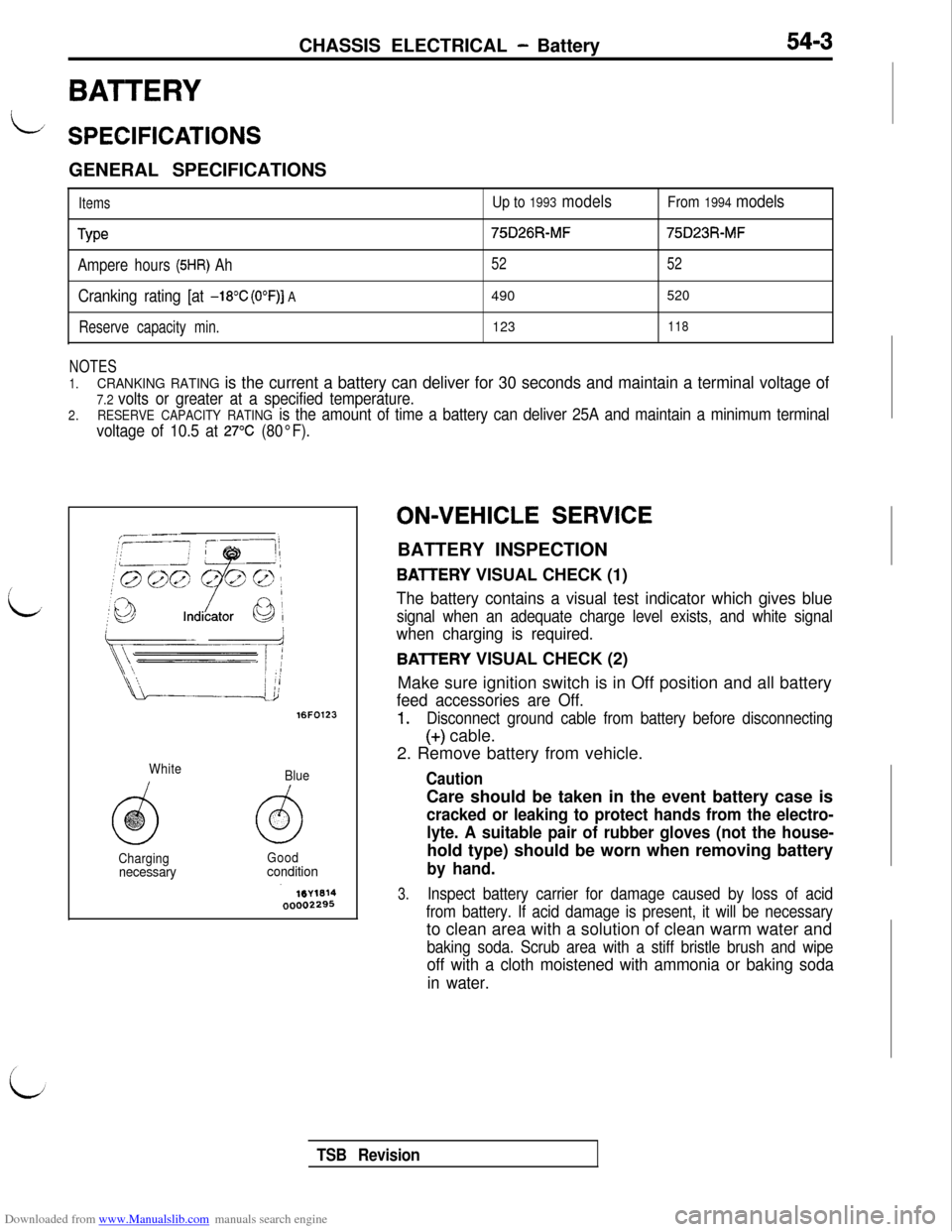
Downloaded from www.Manualslib.com manuals search engine CHASSIS ELECTRICAL - Battery54-3
BATTERY
LSPECIFICATIONSGENERAL SPECIFICATIONS
ItemsUp to 1993 modelsFrom 1994 models
Type75D26R-MF75D23R-MF
Ampere hours
(5HR) Ah5252
Cranking rating [at -18°C (O’F)] A490520
Reserve capacity min.123118
NOTES
1.CRANKING RATING is the current a battery can deliver for 30 seconds and maintain a terminal voltage of
7.2 volts or greater at a specified temperature.
2.RESERVE CAPACITY RATING is the amount of time a battery can deliver 25A and maintain a minimum terminal
voltage of 10.5 at
27% (80°F).
L
16FO123
White
Blue
ChargingGood
necessaryconditionON-VEHICLE
SERVICE
BATTERY INSPECTION
BAlTERY VISUAL CHECK (1)
The battery contains a visual test indicator which gives blue
signal when an adequate charge level exists, and white signal
when charging is required.
BAlTERY VISUAL CHECK (2)
Make sure ignition switch is in Off position and all battery
feed accessories are Off.
1.Disconnect ground cable from battery before disconnecting
(+) cable.
2. Remove battery from vehicle.
CautionCare should be taken in the event battery case is
cracked or leaking to protect hands from the electro-
lyte. A suitable pair of rubber gloves (not the house-hold type) should be worn when removing battery
by hand.
3.Inspect battery carrier for damage caused by loss of acid
from battery. If acid damage is present, it will be necessaryto clean area with a solution of clean warm water and
baking soda. Scrub area with a stiff bristle brush and wipe
off with a cloth moistened with ammonia or baking soda
in water.
TSB Revision
Page 501 of 738
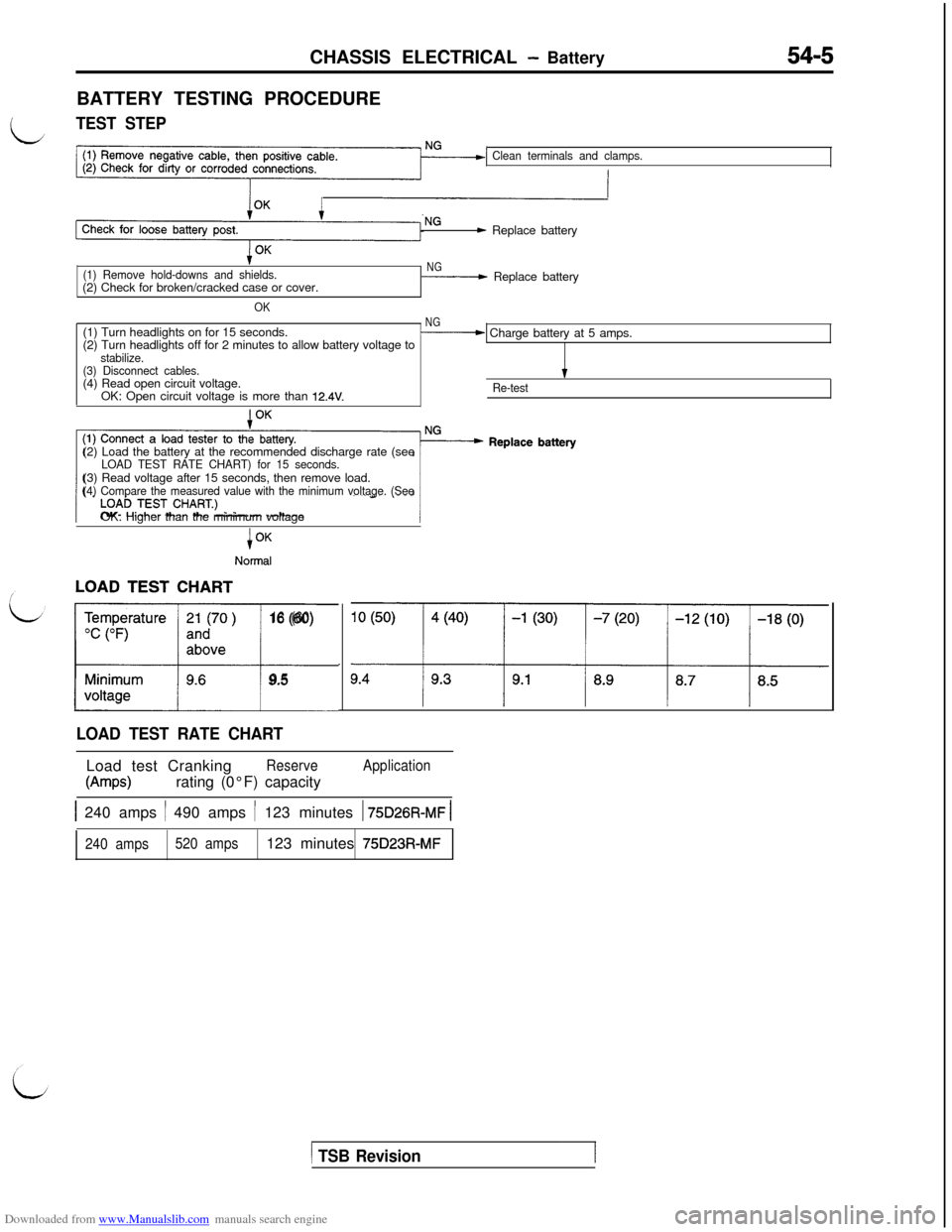
Downloaded from www.Manualslib.com manuals search engine CHASSIS ELECTRICAL - Battery54-5BATTERY TESTING PROCEDURE
LTEST STEP
Clean terminals and clamps.
- Replace battery
(1) Remove hold-downs and shields.(2) Check for broken/cracked case or cover.
OK
NG- Replace battery
(1) Turn headlights on for 15 seconds.
NG(2) Turn headlights off for 2 minutes to allow battery voltage to- Charge battery at 5 amps.
stabilize.
(3) Disconnect cables.(4) Read open circuit voltage.
IOK: Open circuit voltage is more than
12.4V.Re-test(2) Load the battery at the recommended discharge rate (see
LOAD TEST RATE CHART) for 15 seconds.(3) Read voltage after 15 seconds, then remove load.
(4) Compare the measured value with the minimum voltage. (SeeOK: Higher than the minimum voltage
i
Normal
LL16 (60)
9.5
LOAD TEST RATE CHARTLoad test Cranking
Reserve
W-w)rating (0°F) capacity
Application
1 240 amps / 490 amps / 123 minutes 1 75D26R-MF 1
240 amps520 amps123 minutes 75D23R-MF
1 TSB Revision1
Page 504 of 738
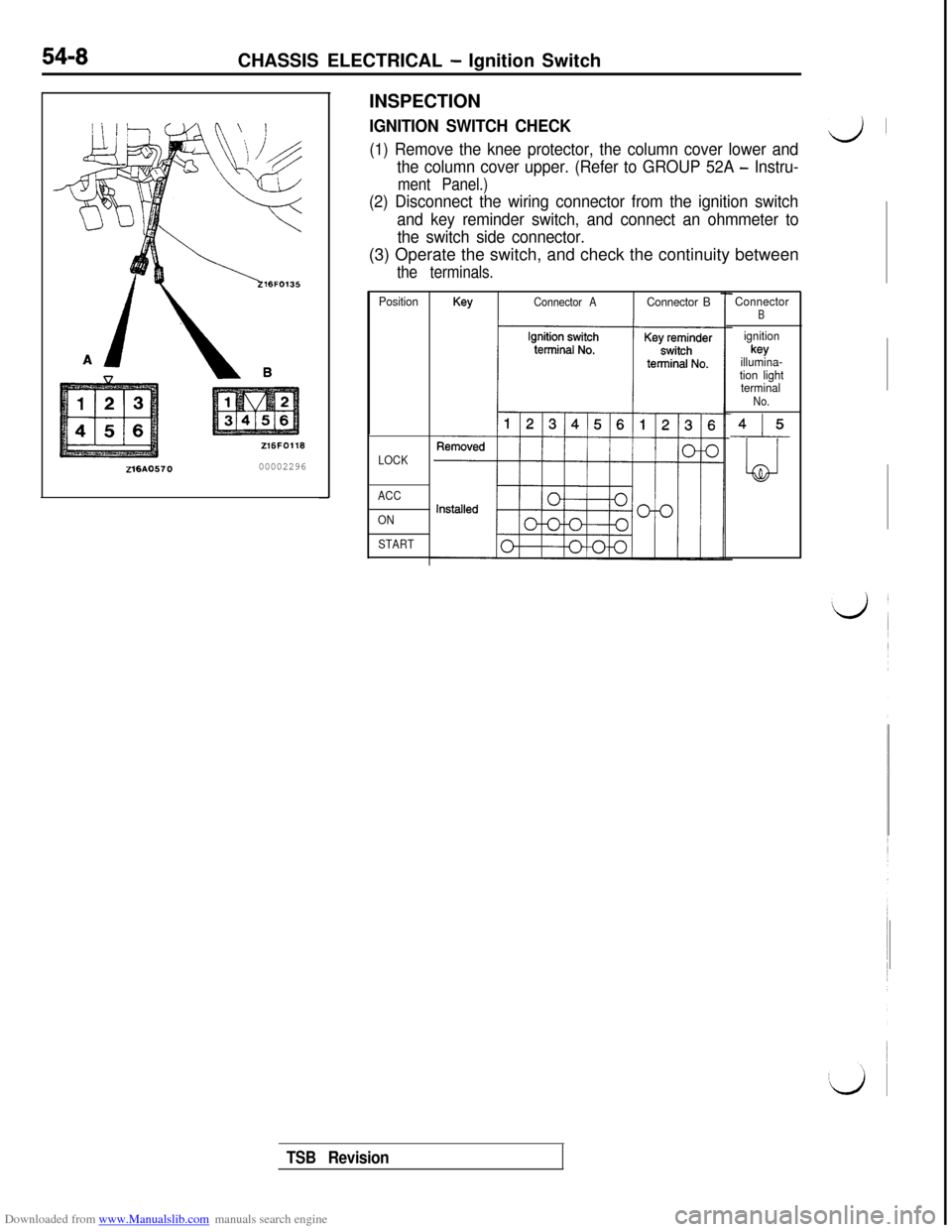
Downloaded from www.Manualslib.com manuals search engine 54-8CHASSIS ELECTRICAL - Ignition Switch
216AO57000002296INSPECTION
IGNITION SWITCH CHECK
(1) Remove the knee protector, the column cover lower andd’
the column cover upper. (Refer to GROUP 52A - Instru-
ment Panel.)
(2) Disconnect the wiring connector from the ignition switch
and key reminder switch, and connect an ohmmeter to
the switch side connector.(3) Operate the switch, and check the continuity between
the terminals.
PositionKeyConnector AConnector B
LOCK
ACC
ON
START
ConnectorB
ignitionkey
illumina-
tion light
terminal
No.
415
LJ
TSB Revision
Page 514 of 738
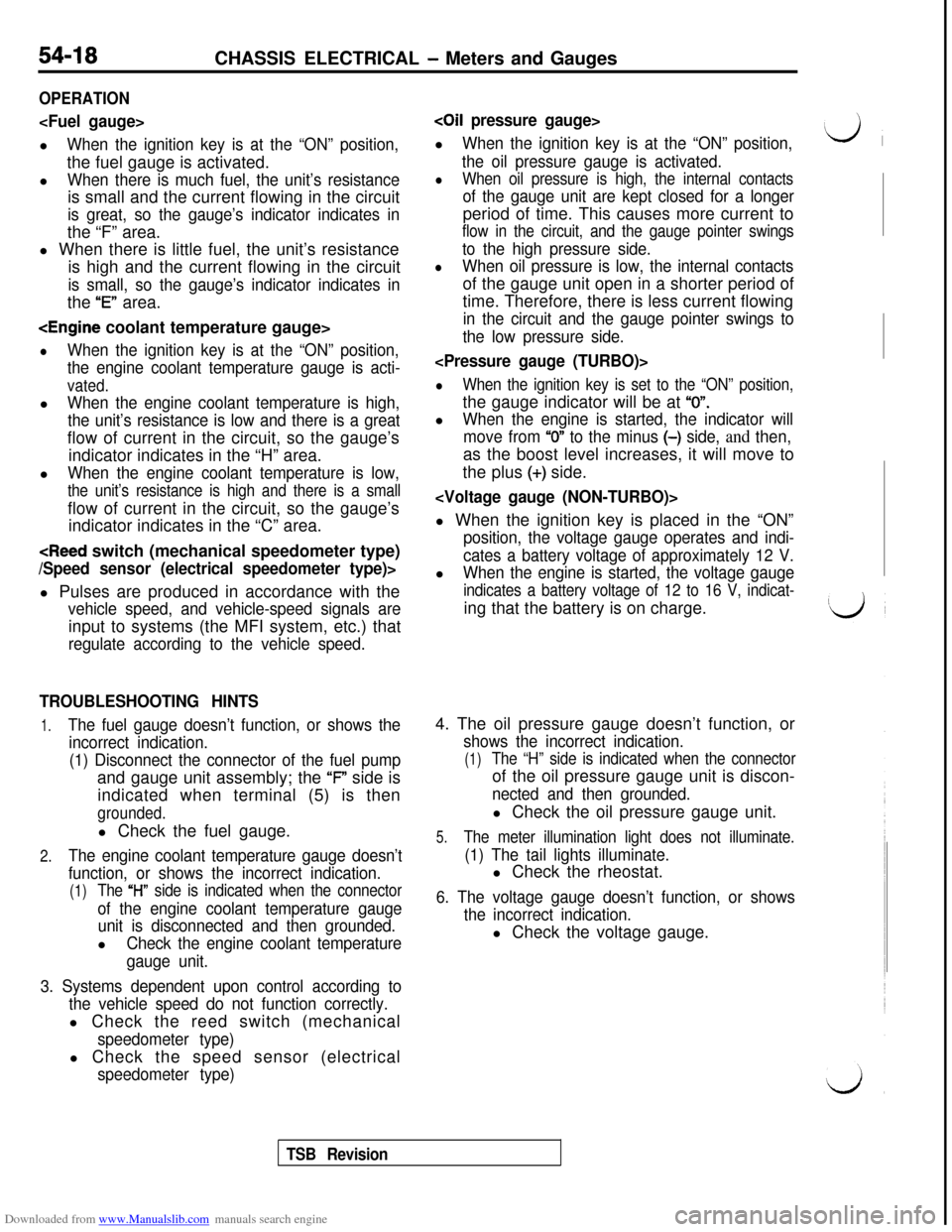
Downloaded from www.Manualslib.com manuals search engine 54-18CHASSIS ELECTRICAL - Meters and Gauges
OPERATION
When the ignition key is at the “ON” position,the fuel gauge is activated.
l
When there is much fuel, the unit’s resistanceis small and the current flowing in the circuit
is great, so the gauge’s indicator indicates inthe “F” area.
l When there is little fuel, the unit’s resistance
is high and the current flowing in the circuit
is small, so the gauge’s indicator indicates inthe
“E” area.
lWhen the ignition key is at the “ON” position,
the engine coolant temperature gauge is acti-
vated.l
When the engine coolant temperature is high,
the unit’s resistance is low and there is a greatflow of current in the circuit, so the gauge’s
indicator indicates in the “H” area.
l
When the engine coolant temperature is low,
the unit’s resistance is high and there is a smallflow of current in the circuit, so the gauge’s
indicator indicates in the “C” area.
vehicle speed, and vehicle-speed signals areinput to systems (the MFI system, etc.) that
regulate according to the vehicle speed.
TROUBLESHOOTING HINTS
1.The fuel gauge doesn’t function, or shows the
incorrect indication.
(1) Disconnect the connector of the fuel pumpand gauge unit assembly; the ‘F” side is
indicated when terminal (5) is then
grounded.l Check the fuel gauge.
2.The engine coolant temperature gauge doesn’t
function, or shows the incorrect indication.
(1)The “l-l” side is indicated when the connector
of the engine coolant temperature gauge
unit is disconnected and then grounded.l
Check the engine coolant temperature
gauge unit.
3. Systems dependent upon control according to
the vehicle speed do not function correctly.l Check the reed switch (mechanical
speedometer type)l Check the speed sensor (electrical
speedometer type)
coil pressure gauge>l
When the ignition key is at the “ON” position,
the oil pressure gauge is activated.
lWhen oil pressure is high, the internal contacts
of the gauge unit are kept closed for a longerperiod of time. This causes more current to
flow in the circuit, and the gauge pointer swings
to the high pressure side.
lWhen oil pressure is low, the internal contactsof the gauge unit open in a shorter period of
time. Therefore, there is less current flowing
in the circuit and the gauge pointer swings to
the low pressure side.
lWhen the ignition key is set to the “ON” position,the gauge indicator will be at
“0”.l
When the engine is started, the indicator will
move from
“0” to the minus (-) side, and then,as the boost level increases, it will move to
the plus
(+) side.
position, the voltage gauge operates and indi-
cates a battery voltage of approximately 12 V.l
When the engine is started, the voltage gauge
indicates a battery voltage of 12 to 16 V, indicat-ing that the battery is on charge.
4. The oil pressure gauge doesn’t function, or
shows the incorrect indication.
(1)The “H” side is indicated when the connectorof the oil pressure gauge unit is discon-
nected and then grounded.l Check the oil pressure gauge unit.
5.The meter illumination light does not illuminate.
(1) The tail lights illuminate.l Check the rheostat.
6. The voltage gauge doesn’t function, or shows
the incorrect indication.l Check the voltage gauge.
TSB Revision
Page 522 of 738
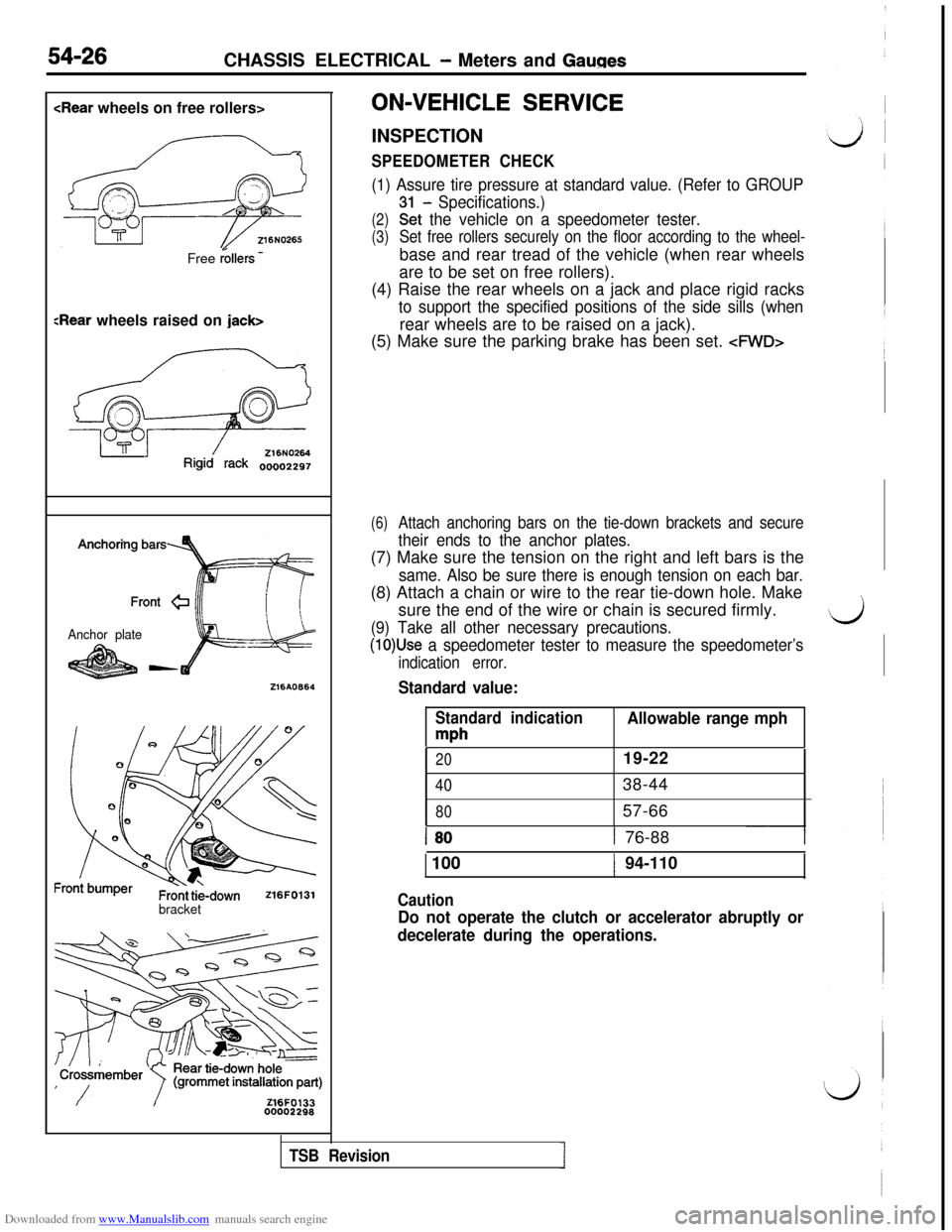
Downloaded from www.Manualslib.com manuals search engine 54-26CHASSIS ELECTRICAL - Meters and Gauges
Free
r&Hers -
Sear wheels raised on jack>
?qi&%!g
Rigid rack oooo2297
Anchor plate
-w216AO864
bracket
/IZ16FO13300002298ON-VEHICLE
SERVICEINSPECTION
SPEEDOMETER CHECK
(1) Assure tire pressure at standard value. (Refer to GROUP
- Specifications.)
(2)Gt the vehicle on a speedometer tester.
(3)Set free rollers securely on the floor according to the wheel-base and rear tread of the vehicle (when rear wheels
are to be set on free rollers).
(4) Raise the rear wheels on a jack and place rigid racks
to support the specified positions of the side sills (whenrear wheels are to be raised on a jack).
(5) Make sure the parking brake has been set.
cPWD>
(6)Attach anchoring bars on the tie-down brackets and secure
their ends to the anchor plates.(7) Make sure the tension on the right and left bars is the
same. Also be sure there is enough tension on each bar.(8) Attach a chain or wire to the rear tie-down hole. Make
sure the end of the wire or chain is secured firmly.
(9) Take all other necessary precautions.
(1O)Use a speedometer tester to measure the speedometer’s
indication error.
Standard value:
Standard indication
mph
Allowable range mph
2019-22
4038-44
8057-66
1 801 76-88--I
1 100
Caution
1 94-110
Do not operate the clutch or accelerator abruptly or
decelerate during the operations.
d
TSB Revision
Page 523 of 738
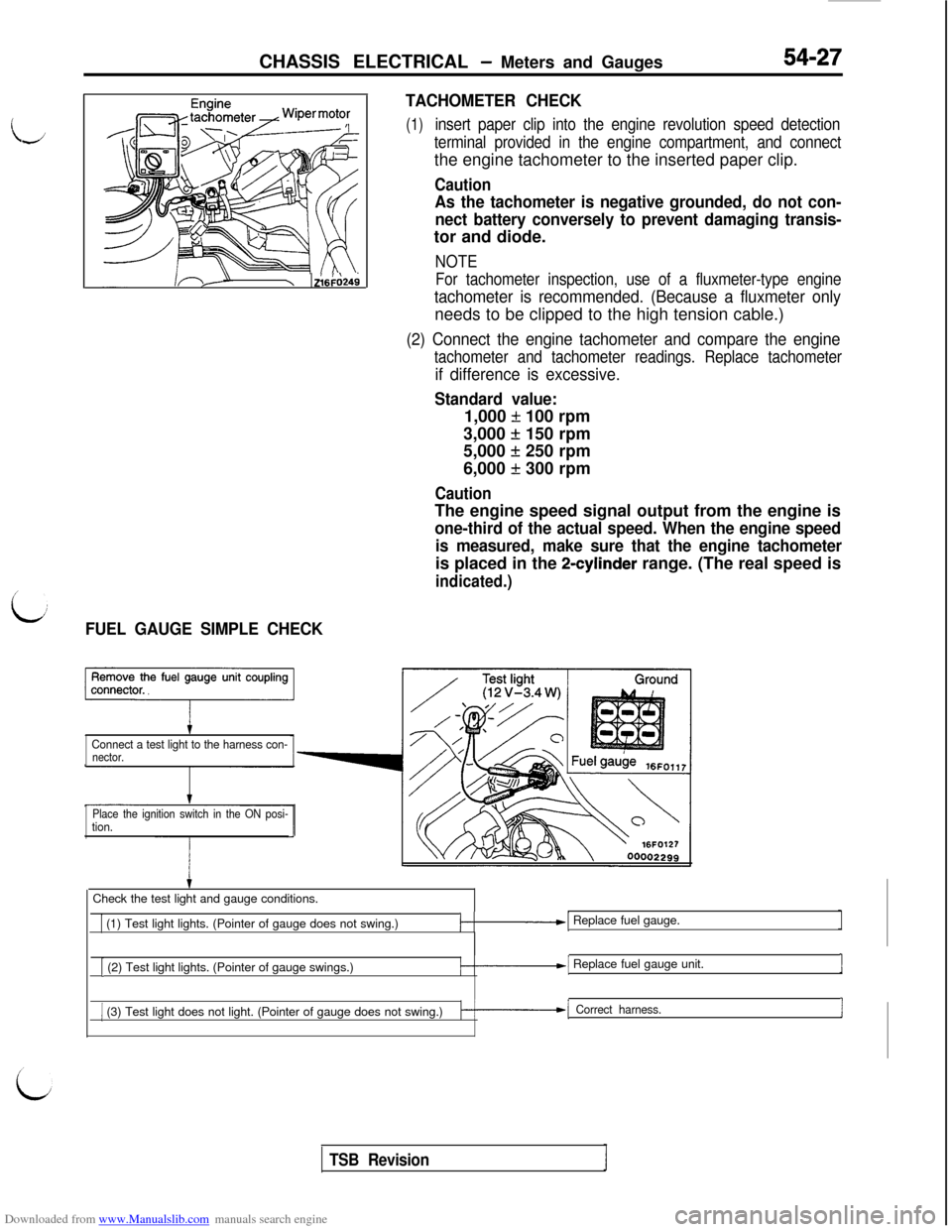
Downloaded from www.Manualslib.com manuals search engine I,;CHASSIS ELECTRICAL
- Meters and Gauges54-27
c I\\ zl6F024;
L:FUEL GAUGE SIMPLE CHECKTACHOMETER CHECK
(1)insert paper clip into the engine revolution speed detection
terminal provided in the engine compartment, and connectthe engine tachometer to the inserted paper clip.
Caution
As the tachometer is negative grounded, do not con-
nect battery conversely to prevent damaging transis-tor and diode.
NOTE
For tachometer inspection, use of a fluxmeter-type engine
tachometer is recommended. (Because a fluxmeter onlyneeds to be clipped to the high tension cable.)
(2) Connect the engine tachometer and compare the engine
tachometer and tachometer readings. Replace tachometer
if difference is excessive.
Standard value:1,000
f 100 rpm
3,000
+ 150 rpm
5,000
f 250 rpm
6,000
f 300 rpm
CautionThe engine speed signal output from the engine is
one-third of the actual speed. When the engine speed
is measured, make sure that the engine tachometeris placed in the
2-cylinder range. (The real speed is
indicated.)
Connect a test light to the harness con-nector.
Place the ignition switch in the ON posi-
tion.Check the test light and gauge conditions.
1 (1) Test light lights. (Pointer of gauge does not swing.)/-.-I Replace fuel gauge.
[ (2) Test light lights. (Pointer of gauge swings.)/-.--I Replace fuel gauge unit.1
1 (3) Test light does not light. (Pointer of gauge does not swing.)k-1 Correct harness.I
TSB Revision
Page 524 of 738
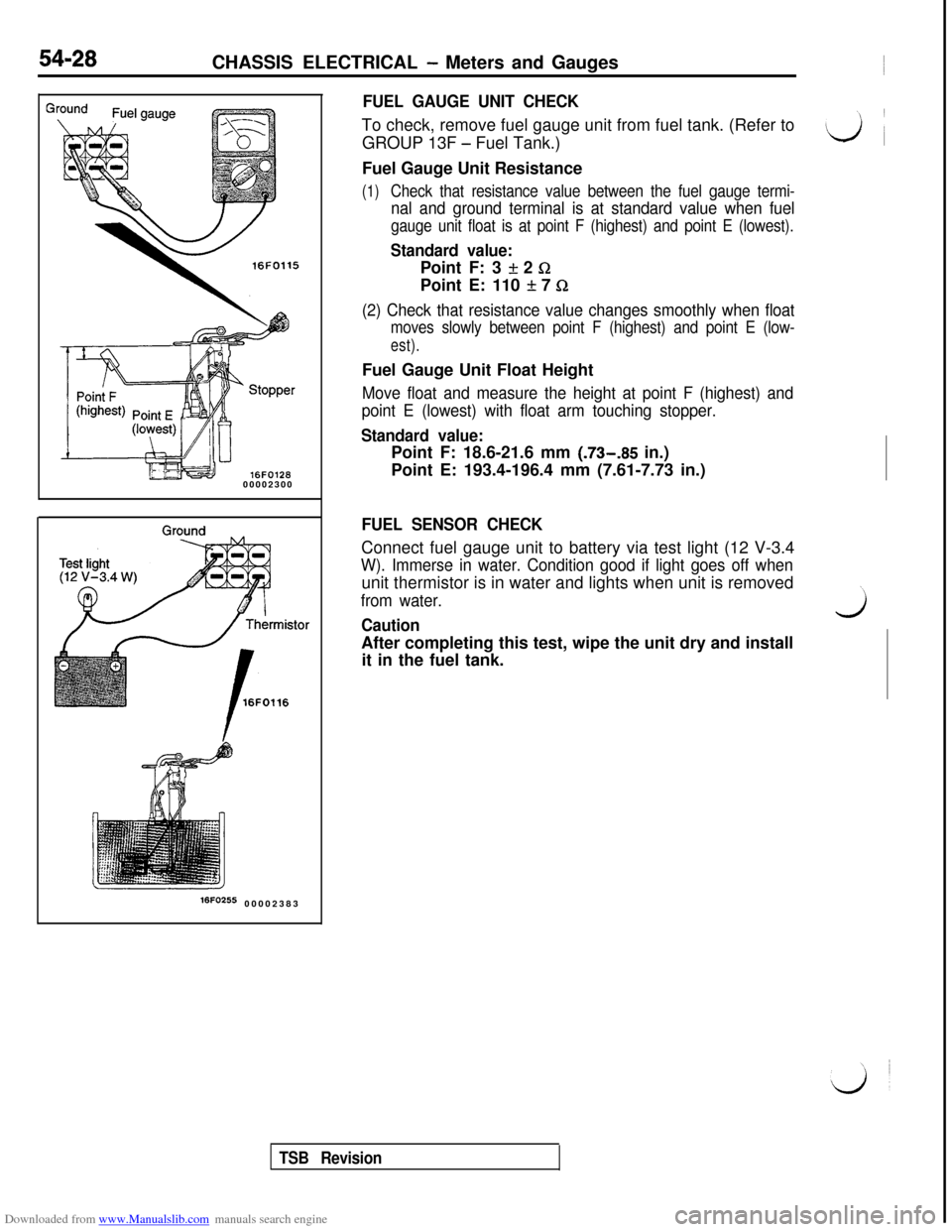
Downloaded from www.Manualslib.com manuals search engine 54-28CHASSIS ELECTRICAL - Meters and Gauges
16FO11500002300
16Fo255 00002383
FUEL GAUGE UNIT CHECKTo check, remove fuel gauge unit from fuel tank. (Refer to
GROUP 13F
- Fuel Tank.)
Fuel Gauge Unit Resistance
(1)Check that resistance value between the fuel gauge termi-
nal and ground terminal is at standard value when fuel
gauge unit float is at point F (highest) and point E (lowest).
Standard value:Point F: 3
If: 2 GPoint E: 110
It 7 Q
(2) Check that resistance value changes smoothly when float
moves slowly between point F (highest) and point E (low-
est).Fuel Gauge Unit Float Height
Move float and measure the height at point F (highest) and
point E (lowest) with float arm touching stopper.
Standard value:Point F: 18.6-21.6 mm (.73-.85 in.)
Point E: 193.4-196.4 mm (7.61-7.73 in.)
FUEL SENSOR CHECKConnect fuel gauge unit to battery via test light (12 V-3.4
W). Immerse in water. Condition good if light goes off whenunit thermistor is in water and lights when unit is removed
from water.
CautionwAfter completing this test, wipe the unit dry and install
it in the fuel tank.
TSB Revision
Page 525 of 738
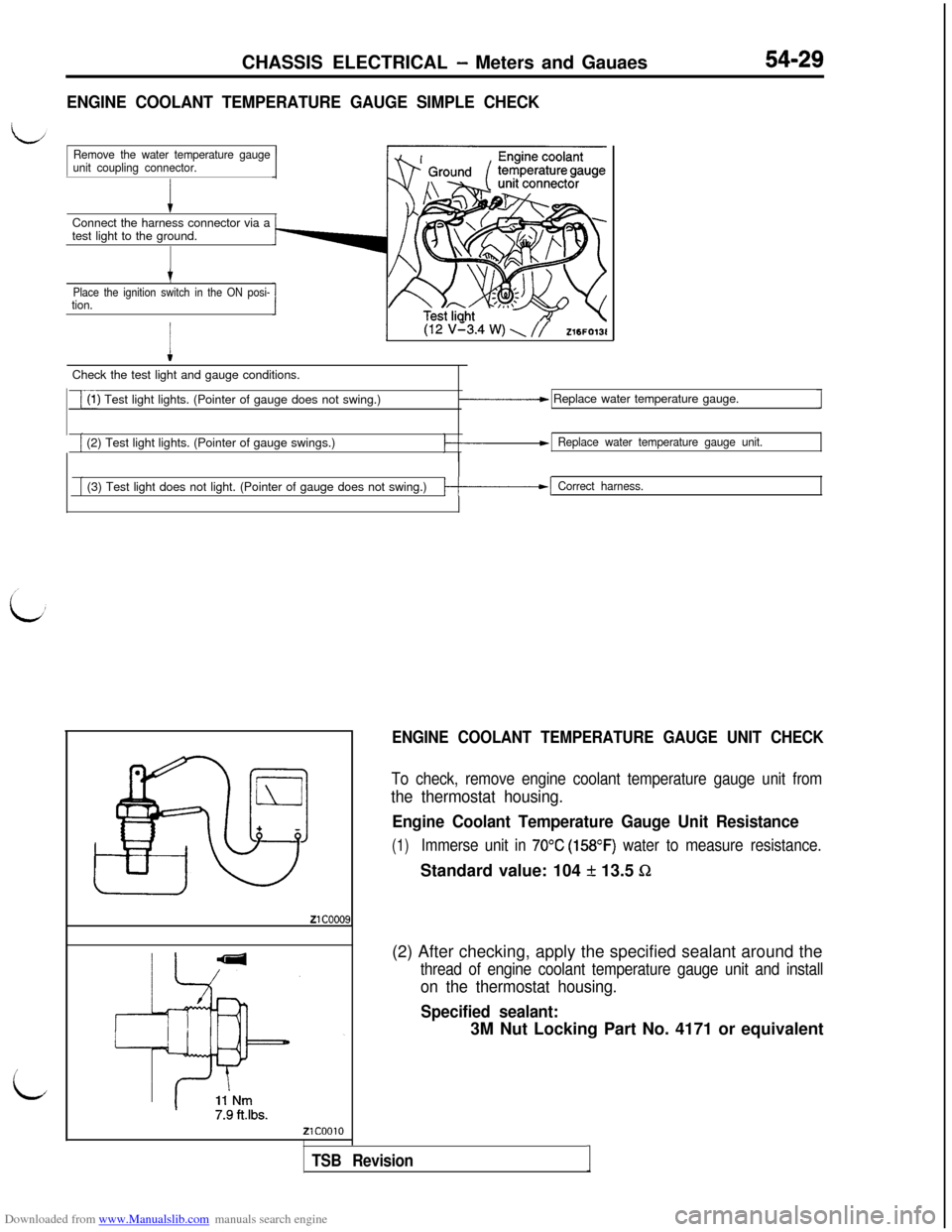
Downloaded from www.Manualslib.com manuals search engine CHASSIS ELECTRICAL - Meters and Gauaes
i
ENGINE COOLANT TEMPERATURE GAUGE SIMPLE CHECKConnect the harness connector via a
test light to the ground.
Remove the water temperature gauge
unit coupling connector.
t
Place the ignition switch in the ON posi-tion.
I
(12 v’3.4 w) \ //Z16FO13lCheck the test light and gauge conditions.
i(1) Test light lights. (Pointer of gauge does not swing.)_____c Replace water temperature gauge.
[ (2) Test light lights. (Pointer of gauge swings.)Replace water temperature gauge unit.
[ (3) Test light does not light. (Pointer of gauge does not swing.)/-------I Correct harness.
ENGINE COOLANT TEMPERATURE GAUGE UNIT CHECK
To check, remove engine coolant temperature gauge unit from
the thermostat housing.
Engine Coolant Temperature Gauge Unit Resistance
(1)Immerse unit in 70°C (158OF) water to measure resistance.Standard value: 104
f 13.5 Sz(2) After checking, apply the specified sealant around the
thread of engine coolant temperature gauge unit and install
on the thermostat housing.
Specified sealant:3M Nut Locking Part No. 4171 or equivalent
TSB RevisionI
Page 526 of 738
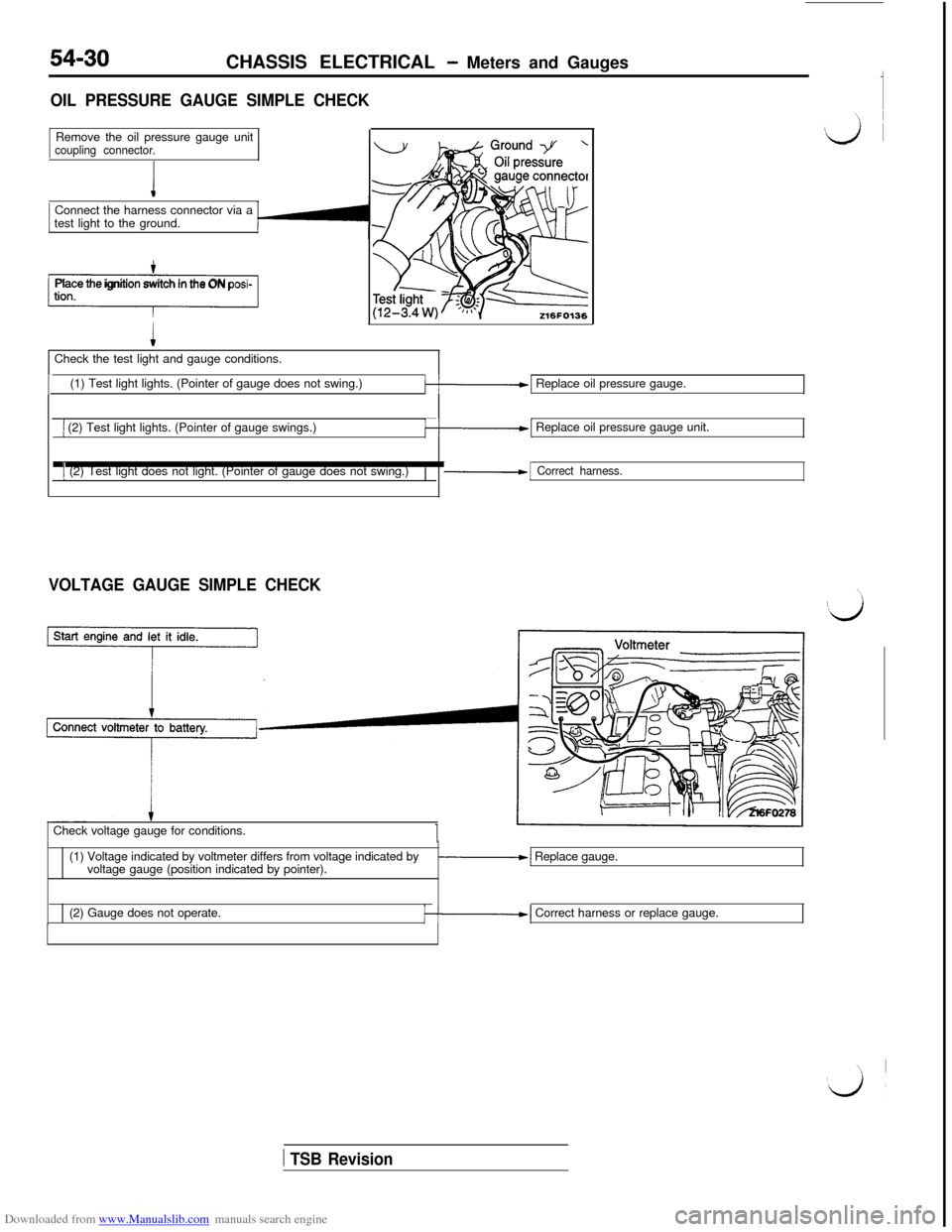
Downloaded from www.Manualslib.com manuals search engine 54-30CHASSIS ELECTRICAL - Meters and Gauges
OIL PRESSURE GAUGE SIMPLE CHECKRemove the oil pressure gauge unit
coupling connector.Connect the harness connector via a
test light to the ground.
-1Place the ignition switch in the ON posi-Check the test light and gauge conditions.
(1) Test light lights. (Pointer of gauge does not swing.)
k-1 Replace oil pressure gauge.
1 (2) Test light lights. (Pointer of gauge swings.)k-1 Replace oil pressure gauge unit.
1 (2) Test light does not light. (Pointer of gauge does not swing.)/-1 Correct harness.
VOLTAGE GAUGE SIMPLE CHECKCheck voltage gauge for conditions.
(1) Voltage indicated by voltmeter differs from voltage indicated by
voltage gauge (position indicated by pointer).
-1 Replace gauge.
(2) Gauge does not operate.
/--I Correct harness or replace gauge.
1 TSB Revision
Page 528 of 738
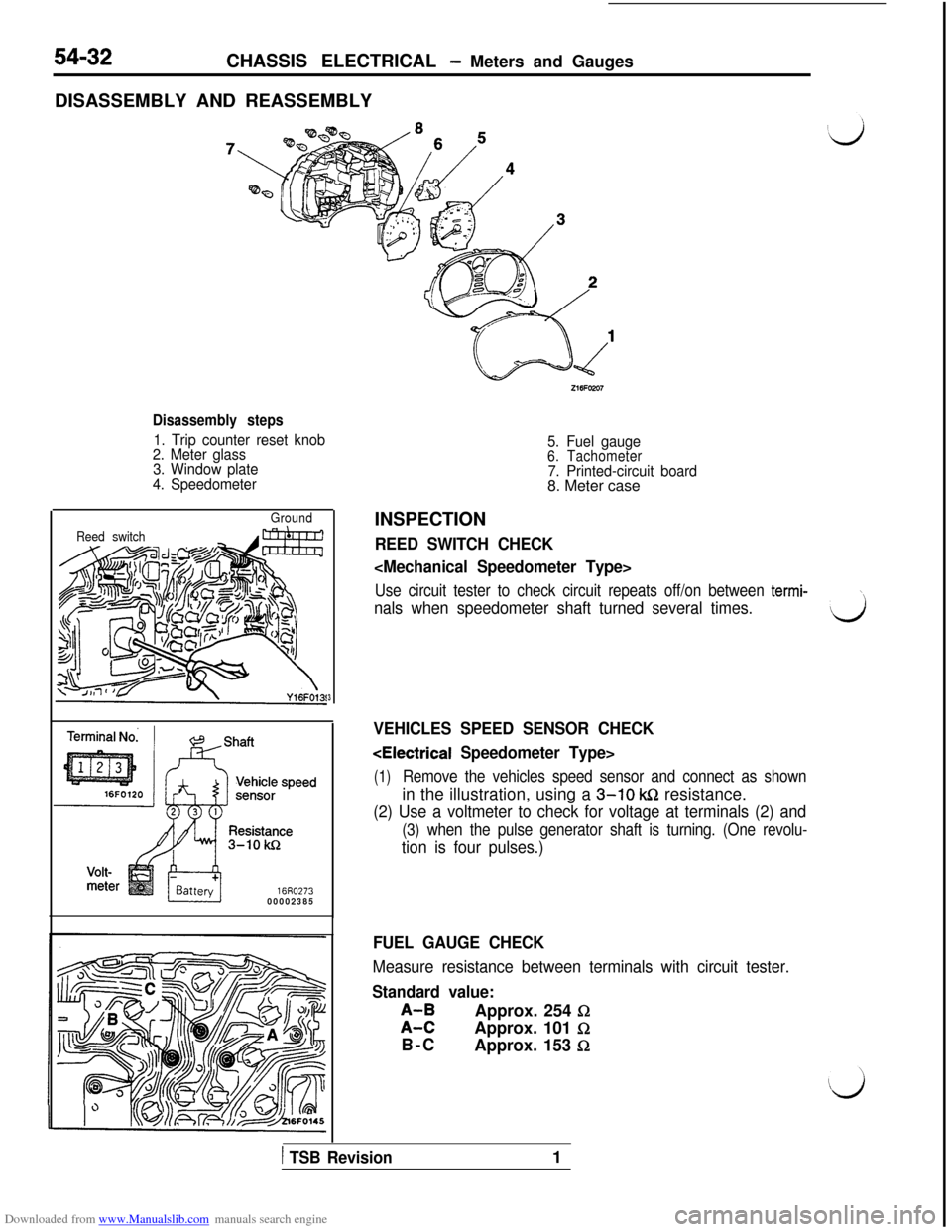
Downloaded from www.Manualslib.com manuals search engine 54-32CHASSIS ELECTRICAL - Meters and Gauges
DISASSEMBLY AND REASSEMBLY
Disassembly steps
1. Trip counter reset knob
2. Meter glass
3. Window plate
4. Speedometer
Ground
Reed switch
16R027300002385
3
5. Fuel gauge6. Tachometer7. Printed-circuit board8. Meter case
INSPECTION
REED SWITCH CHECK
Use circuit tester to check circuit repeats off/on between termi-\
nals when speedometer shaft turned several times.d
VEHICLES SPEED SENSOR CHECK
(1)Remove the vehicles speed sensor and connect as shownin the illustration, using a
3-10 k&2 resistance.
(2) Use a voltmeter to check for voltage at terminals (2) and
(3) when the pulse generator shaft is turning. (One revolu-
tion is four pulses.)
FUEL GAUGE CHECK
Measure resistance between terminals with circuit tester.
Standard value:
;I;Approx. 254 0Approx. 101
I2B-C
Approx. 153
fi
1 TSB Revision1